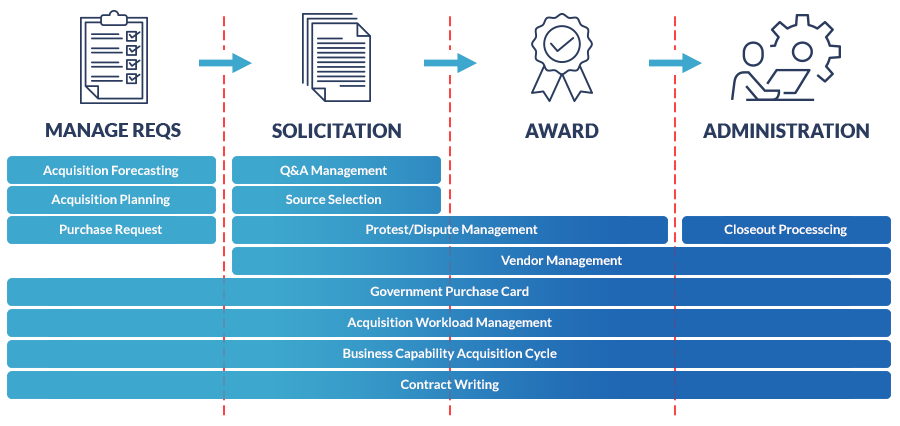
Insight by Appian
Transforming federal procure-to-pay processes with proven automation solutions
Federal acquisition management is ideally suited to benefit from automation.
This content is provided by Appian.
For as long as government acquisition professionals can recall, there have been two long-standing complaints about the process. Program offices complain that the procurement process is long, confusing, and fraught with revisions and requests for additional information. Contracting officers complain that they never receive complete information, have to continually request revisions and additional documentation, and their overall procurement action lead time (PALT) suffers as a result.
The processes, paperwork and volumes of regulations governing how federal program offices and acquisition organizations interact are a bureaucratic maze requiring significant expenditures in time and effort to navigate. In federal procurement, at least 30 percent of a Contract Officer’s time is spent on data entry, matching purchase orders with invoices, and other administrative tasks that put a drag on their valuable time and skills.
And that’s precisely what makes federal acquisition management ideally suited to benefit from automation.
Automation Quickly Reduces Low-Value Procurement Tasks
Shifting from low-value to high-value work is a longstanding goal of federal management agendas – transitioning employees from repetitive administrative and data entry tasks – to work requiring critical thinking and problem-solving skills. For example, automating document management, auto-populating fields in forms and documents, and mapping the proper locations for each document is an invaluable time saver.
Automation enables procurement staff to spend more time on critical tasks, such as improving requirements, market intelligence, reducing costs, risk management, category management, customer service, advancing small business goals, and professional development. So Appian built applications to do just that.
Appian helps organizations improve and standardize their procurement processes for managing requirements, solicitations, awards, and administration. The solutions give organizations the power to modernize every step of the acquisition process, including requirements management, contract writing, award management, vendor management, and close-out.
“One of the benefits of being deployed on a low-code automation platform is that Appian provides agencies with an end-to-end acquisition management solution that allows organizations to tailor the application to their specific needs,” said Ben Allen, Director of Acquisition Solutions at Appian. “Working in the acquisition space for 20 years, we saw that at a high level, the acquisition process is similar, but no one executes at the high level. They execute at the low level and the granular details that are specific to their organization’s mission are critically important to the efficiency of the process.”

Automation Improves Government Acquisition Outcomes
Appian applications integrate directly with federal agencies’ systems of record, leveraging existing IT investment and ensuring smooth data flow between Finance and ERP systems that are critical to a seamless user experience. Appian integrates with Federal Integrated Award Environment systems as well as Department of Defense acquisition systems. A single view of all the acquisition data increases staff productivity, improves program outcomes, and reduces costs. The platform includes robotic process automation (RPA), artificial intelligence (AI), and workflow to improve acquisition management processes, productivity, user experience, and staff engagement.
Agile methodologies and low-code automation enable agencies to quickly configure acquisition solutions that address their needs. Examples of organizations transforming and simplifying their acquisition processes with low-code automation applications include the Air Force, Defense Information Systems Agency, and the General Services Administration. These organizations are improving the value and timeliness of government purchases, optimizing acquisition processes, and reducing PALT.
“Program office and acquisition teams are an active participant in the transformation and modernization process. They provide feedback that is prioritized based on their unique agency and program needs,” Allen said. “Agencies see the new applications and processes within days or weeks. Making the users part of the process helps to break down the barriers to change.”
Simplifying Acquisition Processes with a Requirements Management Solution
Appian developed an acquisition requirements management application that guides program staff through the requirements process for an acquisition package that needs fewer revisions and is immediately actionable by the contracting team. The solution includes automated procurement task and checklist management, so users have quick and easy access to the status of a requisition, which requirements have been fulfilled, and what is still needed. Contracting staff collaborate on the requirements package to ensure all tasks, checklists, and approvals are completed by team members in a timely manner.
The contracting and program teams have the same visibility, which improves how contracting and program teams define, review, and finalize procurement requirements and acquisition strategies. Each acquisition process step is recorded and reportable to identify inefficiencies and help organizations better plan and forecast acquisition throughput and workload required to meet program needs.
A document management framework creates documents and forms that fully comply with the FAR/DFARS, agency supplements, and agency policies. Contract and program teams edit acquisition documents directly from the application. The application submits the requirements package for review and sends the package to the correct contracting group.
“What excites me most about the Requirements Management Solution is the ability to leverage Appian’s full-stack automation capabilities. Technologies like robotic process automation and artificial intelligence are the key to reducing low-value acquisition tasks,” Allen said. “Being able to use the right automation technology to solve the problem from the same platform provides the efficient user experience acquisition professionals deserve.”
Copyright © 2024 Federal News Network. All rights reserved. This website is not intended for users located within the European Economic Area.
Related Stories

DOGE leaders seek telework rollback, but agencies say it improves retention



